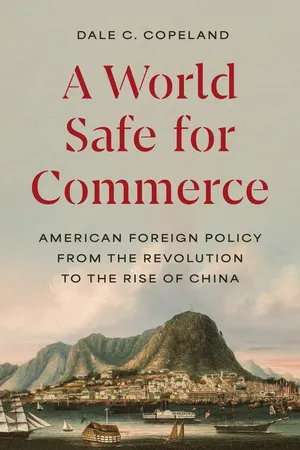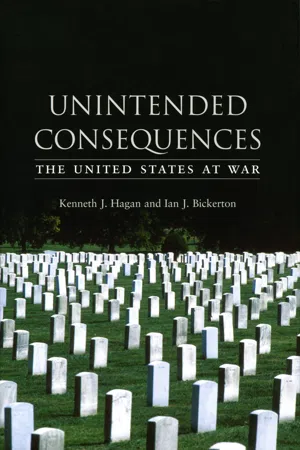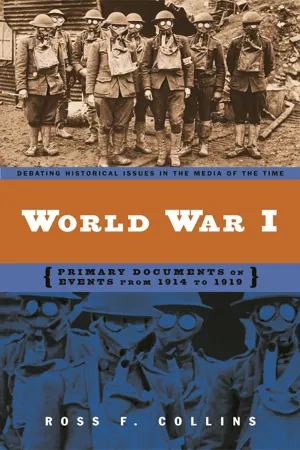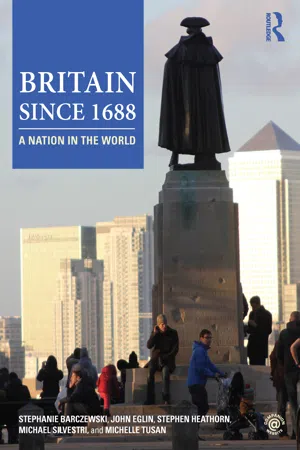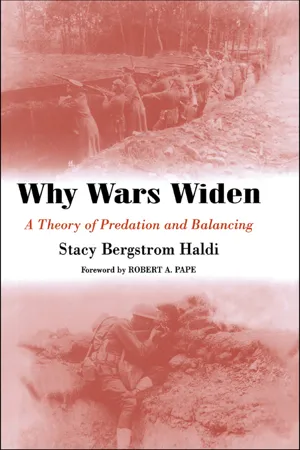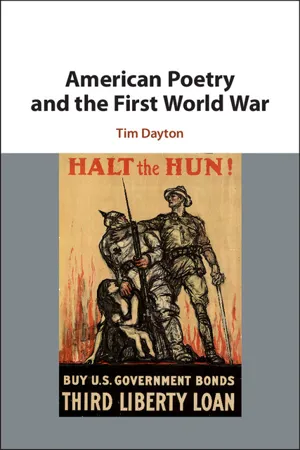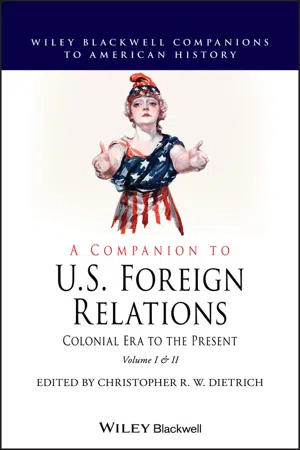History
US Entry into WW1
The United States entered World War I in 1917 after years of neutrality. Factors such as German submarine warfare, the interception of the Zimmermann Telegram, and economic ties with the Allies influenced the decision. President Woodrow Wilson sought to make the world "safe for democracy" and believed American intervention was necessary to achieve peace and stability.
Written by Perlego with AI-assistance
Related key terms
1 of 5
12 Key excerpts on "US Entry into WW1"
- eBook - PDF
A World Safe for Commerce
American Foreign Policy from the Revolution to the Rise of China
- Dale C. Copeland(Author)
- 2024(Publication Date)
- Princeton University Press(Publisher)
189 6 The U.S. Entry into the First World War the american entry into the First World War in April 1917 is one of the great puzzles in the study of American foreign policy. After all, the United States had done very well for itself by staying out of the Great War for the two and half years from August 1914 until March 1917. Its economy by late 1916 was booming, having pulled itself out of the recession of 1913–14 through a qua- drupling of exports to Europe. And by sitting on the sidelines while others bled themselves dry, it was not only growing rapidly in relative economic and military power, but it had shifted from a debtor nation to the world’s primary lending state—with New York overtaking London as the center of global finance. Why not let this favorable situation continue, and then bring America in only at the very end to secure the peace? With U.S. relative power transcen- dent, Washington would have both the clout and the moral influence to per- haps solve the problem of great power war once and for all. This scenario was indeed President Woodrow Wilson’s fervent hope through 1916. The fact that Wilson chose to move his nation to war against Germany in late March 1917, even though Berlin hoped he would not, only adds to the mystery. Yes, Ger- many had returned to unrestricted submarine warfare in late January 1917, and this greatly increased the threat to U.S.-European commerce. Yet German subs had been sinking American merchant ships throughout the war, and on two occasions in 1915 and 1916, after Germany sunk passenger ships with Americans on board, the two countries had been close to war. Yet Wilson had always found diplomatic ways to avoid a war he both feared and found morally dis- tasteful. So why switch to a war footing in March 1917 when diplomacy had succeeded in the past? Historians over the past half-century have offered a number of explanations for the puzzle. - eBook - PDF
- Paul Boyer, Clifford Clark, Karen Halttunen, Joseph Kett(Authors)
- 2017(Publication Date)
- Cengage Learning EMEA(Publisher)
Global Involvements and World War I, 1902–1920 Defining America’s World Role, 1902–1914 (622) What goals underlay America’s early-twentieth-century involvements in Asia and Latin America? The “Open Door”: Competing for the China Market The Panama Canal: Hardball Diplomacy Roosevelt and Taft Assert U.S. Power in Latin America and Asia Wilson and Latin America War in Europe, 1914–1917 (626) Considering both immediate and long-term factors, why did the United States go to war in 1917? The Coming of War The Perils of Neutrality The United States Enters the War Mobilizing at Home, Fighting in France, 1917–1918 (629) How did Washington mobilize the nation for war, and what role did U.S. troops play in the war? Raising, Training, and Testing an Army Organizing the Economy for War With the American Expeditionary Force in France Turning the Tide Promoting the War and Suppressing Dissent (635) How did Americans respond to propaganda and suppression of dissent? Advertising the War Wartime Intolerance and Dissent Suppressing Dissent by Law Economic and Social Trends in Wartime America (638) What was the war’s economic, political, and social impact on the American home front? Boom Times in Industry and Agriculture Blacks Migrate Northward amid New Activist Energies Women in Wartime Public-Health Crisis: The 1918 Influenza Pandemic The War and Progressivism Joyous Armistice, Bitter Aftermath, 1918–1920 (644) How did the League of Nations begin, and why did the Senate reject U.S. membership in the League? Wilson’s Fourteen Points; The Armistice The Versailles Peace Conference, 1919 The Fight over the League of Nations Racism and Red Scare, 1919–1920 The Election of 1920 The Whole Vision (649) 22 WORLD WAR I POSTER URGING FOOD CONSERVATION, BY ILLUSTRATOR JAMES MONTGOMERY FLAGG Home-front propaganda played a key role in mobilizing Americans in support of the war effort in 1917–1918. - eBook - ePub
The Myriad Legacies of 1917
A Year of War and Revolution
- Maartje Abbenhuis, Neill Atkinson, Kingsley Baird, Gail Romano, Maartje Abbenhuis, Neill Atkinson, Kingsley Baird, Gail Romano(Authors)
- 2018(Publication Date)
- Palgrave Macmillan(Publisher)
© The Author(s) 2018Begin AbstractThe Myriad Legacies of 1917 https://doi.org/10.1007/978-3-319-73685-3_3Maartje Abbenhuis ,Neill Atkinson ,Kingsley Baird andGail Romano (eds.)3. American Entry into the First World War as an Historiographical Problem
The views expressed herein are those of the author alone, not those of the Department of Defense, the United States Government, or any portion thereof. End AbstractMichael S. Neiberg1(1) Department of National Security and Strategy, United States Army War College, Carlisle, PA, USAMichael S. NeibergHistorical Methodology and the Study of the First World War
About two years ago, my high school-aged daughter came home with a history worksheet she had to complete for class. It asked which of the four listed events caused the entry of the United States into the First World War. My daughter was suitably pleased that her class was studying the topic her father also studied (so was I), and she wanted to know what I thought of her assignment. She then asked which of the four answers I considered correct. I replied, perhaps unwisely, that none of them was right, but that she should circle answer ‘C’ because that was the answer her teacher was looking for. ‘C’ was the sinking of the Lusitania , an event that occurred almost two years before American entry into the war and thus, as I tried to explain to my confused daughter, not a proximate cause of that event. I might also have explained to her that a survey done in 1915 of 1000 American newspapers found just six in favour of going to war.1 Nor were the members of the United States Congress any more anxious to press for war that year. The Lusitania sinking was important, as I will show in this chapter, but not as a cause of American entry into the war.The fault for Americans’ amnesia about the First World War lies not with the teachers, but with a major gap in our historical understanding of the topic. Surprisingly few scholars have wrestled in any detail with the reasons for the country’s entry into the war in 1917. As a topic for historical analysis, it has generally failed to generate the heated debates that accompany the scholarship on the British, Austro-Hungarian, Russian, and, of course, German involvement in the conflict. A scholarly study of American entry published in 2011 claimed to be a ‘new’ history of the subject, but it rehashed the same documents, the same debates, and the same people as the scholarship had for several decades.2 - eBook - ePub
Unintended Consequences
The United States at War
- Kenneth J. Hagan, Ian J. Bickerton(Authors)
- 2007(Publication Date)
- Reaktion Books(Publisher)
SIXTHE UNITED STATES INWORLD WAR I , 1917–18
It is much easier to make war than peace.Georges Clemenceau, Paris, 19191The course and outcome of World War I were nothing like the expectations of the participants. No-one anticipated the length, the scale of the slaughter, or the outcome of that most dreadful war the world had yet seen. Nearly ten million combatants and non-combatants lost their lives in the years between 1914 and 1918, and for much of the war no-one knew how to end the conflict. The armistices and subsequent peace treaties created a world, certainly a European world, vastly different from that envisaged by those who took up war. President Woodrow Wilson asserted that the United States entered the war to make the world ‘safe for democracy’ and to bring ‘peace and safety to all nations’, but within twenty years the world faced an even greater cataclysm.The United States had no intention of entering the war in 1914. The nation was ill-prepared for a major war. There was no immediate military threat to the nation’s security. As the war dragged on, the Wilson administration gradually convinced itself that if the United States were to function as a world power, its long-term national interest required active belligerent involvement in the war. By the end of 1916 Wilson and his advisors had reached the conclusion that if the United States did not intervene militarily on the side of the Anglo–French–Russian coalition, Germany and its allies would probably win the war. They believed a triumphant and all-powerful Germany would threaten American interests around the world, especially in the Caribbean, offering a challenge to America’s hemispheric security. Germany’s use of submarines to sink merchant vessels, which resulted in the loss of American lives and weapons secretly being shipped to Britain, constituted the trigger that led to a congressional declaration of war against Germany in April 1917. - eBook - ePub
Wilsonian Approaches to American Conflicts
From the War of 1812 to the First Gulf War
- Ashley Cox(Author)
- 2017(Publication Date)
- Taylor & Francis(Publisher)
This chapter will begin by addressing the traditional debates that focus on how the United States went to war for strategic and economic reasons. The second section will move on to discuss the Wilsonian interpretation of the events. The final section will address how we can use Mead’s Wilsonian framework to interpret Wilson’s decision for conflict and why this framework is an important analytical tool.The debateThis section will review the arguments that have been classically used to explain the American entry into the First World War. It will then go on to discuss the economic arguments that surrounded American entry into the conflict.The first strategic factor to consider is the classical interpretation of the origins of the First World War, which is that the United States acted only in its own strategic interest.7 This argument suggests that the United States had no need to concern itself with events in Europe until 1917 because Britain had been able to contain any potential hegemon. This section will begin by addressing the neo-realist assertion that the United States had pursued a ‘buck passing’8 strategy up to 1917 allowing the Allies to pay the price of containing Germany.9 This policy changed, so the realist argument goes, as the tide appeared to turn against the Allies in 1917. Thus the United States was forced to support the Allies when presented with potential German hegemony in Europe. In this analysis a victorious Germany would not only possess the strongest army in the world10 but it would shatter British naval supremacy, which played an important part in enforcing the Monroe doctrine.11 With the great powers of Europe defeated, Germany would be unopposed on its borders and as such could attempt to spread its influence to the new world and pose a threat to the United States.12 This scenario would not be appealing for the United States, which owed its own success in the Western Hemisphere to the lack of peer competitors and the balance of the European great powers. John Mearsheimer contends that ‘the United States entered World War One in good part because it thought that Germany was gaining the upper hand’.13 - eBook - PDF
World War I
Primary Documents on Events from 1914 to 1919
- Ross F. Collins(Author)
- 2007(Publication Date)
- Greenwood(Publisher)
http://books.mirror.org/gb.montaigne.html. 121 C h a p t e r 8 U.S. Foreign Policy in the World War I Era I n August 1914 Woodrow Wilson was just a year and a half into his first term as president, following one of the most significant elections in U.S. history. The new century had greeted an America facing tremen- dous social, cultural, and political change. Massive industrial growth had turned a generally agrarian country into a great power of the machine age. Huge fortunes floated tycoons of immense wealth and power while average Americans worked long hours at low pay in dangerous conditions. Racial hatred had reached a zenith not seen since days of slavery, with hundreds of blacks lynched every year. A large immigrant population sent children to work, lived in squalid tenements, and more and more often supported the socialist press. Socialism during this period reached the highest mainstream audi- ence in America that it would ever see. In 1912 one of Wilson’s credible opponents for president was Socialist Party candidate Eugene V. Debs, who campaigned against the power of capitalism. In 1916 he won election to the House of Representatives from Indiana, but the 1918 war hysteria brought him to jail for a vaguely antiwar comment that was part of a longer speech. (He was pardoned without apology three years later by the Hard- ing administration.) In the plains states, farmers representing strong immi- grant populations struck against eastern financial interests by establishing a home-grown socialist party, the Non-Partisan League. The league was particularly influential during World War I, complaining that prowar forces merely shilled for capitalists who demanded war to protect their financial interest in an allied victory. The role of the changing nation so split political parties that Republi- cans tore off to form a new party, the Progressives or “Bull-Moose” Party. - eBook - ePub
Britain since 1688
A Nation in the World
- Stephanie Barczewski, John Eglin, Stephen Heathorn, Michael Silvestri, Michelle Tusan(Authors)
- 2014(Publication Date)
- Routledge(Publisher)
9 The First World WarTopics covered• British entry into the First World War • Popular support for the war • Military course of the war • Domestic response of the government to the war • Manpower crisis and the implementation of conscription • The British Empire in the war • Easter Rising in Ireland • Social changes caused by the conflict and the rise of state intervention • Costs and consequences of the warTimelineJuly 1914 Diplomatic crisis in Europe August 1914 Britain declares war on Germany and Austria–Hungary September 1914 Indian troops arrive on the Western Front April 1915 First landings on Gallipoli Peninsula May 1915 Formation of coalition government January 1916 Conscription introduced April 1916 Easter Rising in Dublin July 1916 Battle of Somme begins December 1916 Lloyd George becomes Prime Minister of new coalition government April 1917 United States declares war on Germany July 1917 Third Battle of Ypres (Passchendaele) begins December 1917 Russia makes peace with Germany February 1918 Representation of the People Act March 1918 German offensive on the Western Front November 1918 Armistice IntroductionThe First World War (often referred to in Britain as the “Great War”) was a shock to the British. Fought largely in an effort to preserve the status quo in terms of both Britain’s international position and the domestic political and social order, the war instead significantly altered both. Yet it did not represent a total rupture with the past: Britain was not convulsed by revolution as were some other European countries that fought in the war. Britain’s political system and social structure were forced to bend and adapt, but they did not break.Britain’s entry into the warImmediately after the Archduke Franz Ferdinand was assassinated by a Serbian nationalist in Sarajevo in June 1914, it was not clear that the dispute between Austria– Hungary and Serbia would escalate into a major war. Across Europe, many hoped that this would be yet another of the conflicts that had plagued the Balkan region since 1908, none of which had activated the two great European alliances that had been in place since the 1890s. On the one hand, there was the Triple Alliance of Germany, Austria–Hungary, and Italy; on the other, there was the Dual Alliance of France and Russia. British politicians, meanwhile, proudly referred to their country’s lack of European entanglements. Yet Britain’s apparent isolation was deceptive, for throughout the nineteenth century, the British had worked to maintain a balance of power in Europe. Moreover, a subtle reorientation of British foreign policy had occurred during the decade leading up to 1914. In the late nineteenth century, Germany had been viewed as a potential ally by Britain, but its aggressive diplomacy and pursuit of colonies engendered suspicion. Meanwhile, colonial disputes between the British and French and the British and Russians were partially papered over by two agreements, or ententes, in 1904 and 1907. These were not formal alliances, but the ententes - eBook - ePub
Writing the Great War
The Historiography of World War I from 1918 to the Present
- Christoph Cornelissen, Arndt Weinrich, Christoph Cornelissen, Arndt Weinrich(Authors)
- 2020(Publication Date)
- Berghahn Books(Publisher)
The merchants-of-death argument resonated powerfully enough to spur Congress to adopt a series of neutrality laws from 1935 to 1939 that sought to limit American economic ties to belligerent nations as war clouds gathered once again in Europe. These laws restricted arms sales, loans, and transport of goods with nations at war, encapsulating the widespread view that actions by financial elites had forced the nation to fight an unpopular war that ultimately harmed the nation. Even after Adolf Hitler began his wars of conquest throughout Western Europe, the merchant-of-death argument held sway and slowed the sending of aid to Great Britain. Before the Japanese attack on Pearl Harbor brought the United States into the war in 1941, FDR had to work around the edges of the politically popular neutrality laws through programs like lend-lease, which claimed that the United States was “lending” rather than “selling” arms to Great Britain.The last overt influence of the war on American political culture came when FDR and his advisors tried to “learn lessons” from Wilson’s bungled management of the peace process. After World War I, the United States rejected the controversial Versailles peace treaty and refused to join the League of Nations. To develop a strong relationship with the Senate (the body that ratifies treaties), Roosevelt chose Missouri senator Harry S. Truman as his running mate in 1944 and enlisted early support from prominent Republicans for his plans. The popular view that America’s interwar isolationism had emboldened imperial militarism worldwide also convinced Americans that the United States needed to take a leading role in creating and maintaining the United Nations.Beginning and Ending the War
Political and diplomatic historians have focused on two essential questions: Why did the United States enter World War I, and why, having won the war, did the United States lose the peace? Over the decades, historians have disagreed over whether financial ties to the Allies, concerns about German aggression, or a desire to shape the peace ultimately prompted President Woodrow Wilson to abandon neutrality for belligerency. Historians have also continually debated how the new vision of American world leadership articulated by Wilson through his peace platform shaped the “American Century.” - eBook - ePub
- John Mueller(Author)
- 2013(Publication Date)
- Cornell University Press(Publisher)
CHAPTER 3
WORLD WAR I AS A WATERSHED EVENT
European attitudes toward war changed profoundly at the time of World War I. There is no way to quantify this change except perhaps through a rough sort of content analysis. Before the First World War it was very easy, as documented in the previous chapter, to find serious writers, analysts, and politicians in Europe and the United States exalting war as desirable, inevitable, natural, progressive, and necessary. After the First World War, such pronouncements become extremely rare, although the excitement of the combat experience continued (and continues) to have its fascination to some.1This suggests that the appeal of war, both as a desirable exercise in itself and as a sensible method for resolving international disagreements, diminished markedly on that once war-racked continent. In an area in which war had been accepted as a standard and permanent fixture, the idea suddenly gained substantial currency that war there was no longer an inevitable or necessary fact of life and that major efforts should be made to abandon it.This change has often been noted by historians and political scientists. Arnold Toynbee points out that World War I marked the end of a “span of five thousand years during which war had been one of mankind’s master institutions.” In his study of wars since 1400, Evan Luard observes that “the First World War transformed traditional attitudes toward war. For the first time there was an almost universal sense that the deliberate launching of a war could now no longer be justified.” Bernard Brodie points out that “a basic historical change had taken place in the attitudes of the European (and American) peoples toward war.” Eric Hobsbawm concludes that “in 1914 the peoples of Europe, for however brief a moment, went lightheartedly to slaughter and to be slaughtered. After the First World War they never did so again.” And K. J. Holsti observes, “When it was all over, few remained to be convinced that such a war must never happen again.”2 - eBook - ePub
Why Wars Widen
A Theory of Predation and Balancing
- Stacy Bergstrom Haldi(Author)
- 2004(Publication Date)
- Routledge(Publisher)
US military planning during the war, including the 1916 Naval Act, was geared toward dealing with the victor. 63 Now it appeared that Germany could emerge victorious, with dominance over Europe, shattering hopes for a favorable postwar balance. If Great Britain were defeated, the Royal Navy could no longer serve as a shield protecting the western hemisphere from other European powers, as it had been doing for years. 64 Wilson asked Congress for a Declaration of War on 2 April 1917. At first the United States declared war only on Germany—not only because Germany was the only belligerent to wage unrestricted submarine warfare, but also in hopes of drawing off its allies. When that failed, Washington declared war on Austria in December. The USA did not, however, become one of the Allies. Instead, it was an ‘associated power’. 65 The United States entered World War I to prevent a German victory and gain some leverage at the peace table in order to help implement a stable postwar balance of power. The United States did not enter the war because of any alliance commitments; it maintained none, either before or after it entered. As long as there was a stalemate in Europe, it was not immediately threatened, and indeed prospered. But, facing the prospect of German hegemony over Europe, combined with such industrial and naval power, the United States chose to defend its interests immediately rather than await the potential longterm threat. TO JOIN? SMALLER POWERS Turkey Turkey did not enter the war until November 1914, after its German ally committed an act of war in its name. Whether Turkey would have finally taken up arms otherwise is a matter for speculation. Turkey did have strong motives for throwing in its lot with the Central Powers - eBook - PDF
- Tim Dayton(Author)
- 2018(Publication Date)
- Cambridge University Press(Publisher)
From the springboard of generally accepted presuppositions about America and its relation to the rest of the world, Wilson crafted a justification for and vision of American intervention in the First World War. This justification and this vision illuminate vital aspects of American culture, especially – but not only – in the twentieth century. They would set up, among other things, the characteristic antipathy between literary modernism – a major compo- nent of what Lionel Trilling in the s would identify as an “adversary culture” (xv) – and the traditional culture of the social and cultural elites who reigned prior to the war, and who attempted, with uneven success, to maintain their position afterward. Wilson’s justification of direct American intervention into the war faced an immediate difficulty. In the combatant nations of Europe, the war could be – and was – seen as defensive in a straightforward, territorial sense. Thus, while men were willing to fight, this willingness was generally based on “defensive patriotism,” and not “enthusiasm for war as such” (Clark ). Wilson would have to present the United States as declaring war on some basis other than territorial defense since the Atlantic Ocean presented an insuperable barrier to invasion, even were Germany so inclined. Wilson could point to provocations: unrestricted submarine warfare meant the loss of American lives, German agents had sabotaged munitions plants that supplied the Allies, and a proposal had been tendered that Mexico join the side of Germany should the United States declare war. But the Allies, especially the United Kingdom, primary enforcer of a naval blockade of the Central powers, had also provoked the United States. Wilson had to present something more compelling, and more elaborate, than the thin case for self-defense. - eBook - ePub
A Companion to U.S. Foreign Relations
Colonial Era to the Present
- Christopher R. W. Dietrich(Author)
- 2020(Publication Date)
- Wiley-Blackwell(Publisher)
Chapter Fifteen Wilson's Wartime Diplomacy : The United States and the First World War, 1914–1918Ross A. KennedyAmerican foreign policy during World War I has generated contentious debates among historians seeking to understand its character and significance. This essay will focus on President Woodrow Wilson's diplomacy toward the Allies and Germany from 1914 through the conclusion of the armistice on November 11, 1918. Although Wilson's statecraft produced a lively debate between his defenders and so‐called “revisionists” in the 1920s and 1930s, the essay's historiographical analysis will limit itself to major works published in the last sixty years or so. Broadly speaking, these relatively recent historians have divided into two camps. The first consists of scholars who largely follow the interpretation of Arthur S. Link, Wilson's leading biographer and the editor of a sixty‐nine volume collection of the president's papers. This group includes prominent historians such as John Milton Cooper, Jr., and Thomas J. Knock. They portray Wilson as a pragmatic idealist and have few criticisms of the president's approach toward the war. The second group is more diverse in their views but its members share a tendency to qualify or reject Link's interpretation. The Link school's narrative has for all practical purposes become the “standard” one in the field – the interpretation, in other words, that most other scholars react to in one way or another.The Neutrality Period
The standard interpretation and its alternatives diverge most clearly in how they analyze Wilson's policy on neutral rights from August 1914 to April 1917, when the United States entered the war. The standard argument emphasizes that Wilson tried to be as impartial as he could toward the belligerents. Link concedes that early on Wilson expressed “sympathy” for the Allies; privately stated that a German victory would force the United States to become a “military nation;” and accommodated Britain's initial maritime system, including a minefield laid in the North Sea, that aimed to cut off Germany's trade with the outside world (Link 1960 , 50–51). But Link and his supporters nevertheless argue that Wilson was not biased in favor of the Allies. They dismiss the president's early statements of fear and hostility toward Germany as “emotional reactions” brought on by Germany's invasion of Belgium and its initial military success against France (Link 1960 , 51). Once the Allies stopped the German advance in mid‐September 1914 and Wilson had time to think hard about the war, he adopted a stance marked by “a remarkable degree of detachment, impartiality, and understanding” (Link 1960
Index pages curate the most relevant extracts from our library of academic textbooks. They’ve been created using an in-house natural language model (NLM), each adding context and meaning to key research topics.
